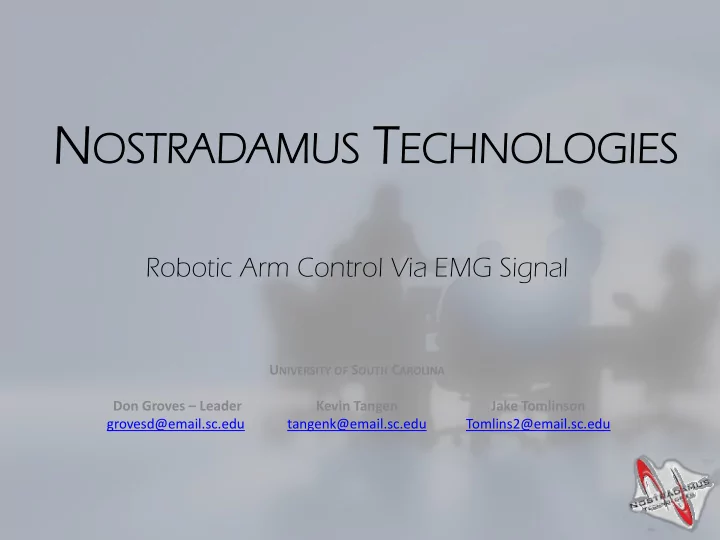

N OSTR MUS T ECH NOLOGIES TRADA ADAMUS CHNOLOGIES Robotic Arm Control Via EMG Signal U NIVERSITY OF S OUTH C AROLINA Don Groves – Leader Kevin Tangen Jake Tomlinson grovesd@email.sc.edu tangenk@email.sc.edu Tomlins2@email.sc.edu
Problem Definition • Global need for specialized surgeons – Third world countries – Hostile environments • Obstacles: – Time – Money – Safety
Background • Current robotic systems: – Supervisory control system – Telesurgical system • Da Vinci surgical system – Shared control system
Components
Project Progression BioRadio AL5B • EMG Signals • Signal Filtering • Differential Signal Analysis • Programming • Signal Amplification • Muscles • LabVIEW Integration Languages • 3 Servo Motors • Data Collection • BioRadio Control • Robotic Arm Models • Practice Controlling • LabVIEW Integration Research LabVIEW Full System
LabVIEW Program
LabVIEW Control Panel
Results Develop a VI in LabVIEW to control all components Control a single servo motor using a live EMG Perform tests to Incorporate three assess accuracy EMG channels and precision
Data Pointing Accuracy Depth Test Trial Distance from Target (cm) Trial Target Depth (cm) Experimental (cm) Percent Error 1 3.00 1 2.00 4.50 125.00 2 1.20 2 2.00 3.70 85.00 3 0.40 3 2.00 0.70 65.00 4 2.30 4 2.00 2.60 30.00 5 0.80 5 2.00 3.10 55.00 6 0.60 6 2.00 1.60 20.00 7 1.10 7 2.00 2.10 5.00 8 0.50 8 2.00 2.40 20.00 9 0.20 9 2.00 1.80 10.00 10 0.80 10 2.00 1.90 5.00 Test Cut Length Trial Target length (cm) Experimental (cm) Percent Error 1 8.00 5.50 31.25 2 8.00 2.40 70.00 3 8.00 6.00 25.00 4 8.00 8.50 6.25 5 8.00 9.30 16.25 6 8.00 6.90 13.75 7 8.00 7.60 5.00 8 8.00 7.20 10.00 9 8.00 5.80 27.50 10 8.00 8.20 2.50
Wrist Control • Video
Elbow Joint • Video
Shoulder Control • Video
Robotic Arm Arc Cut • Video
Twitchy Cut • Video
Failed Cut • Video
Successful Cut • Video
Straight line • Video
Robotic Arm 2-Planes • Video
Robotic Arm Back and Forth • Video
Obstacles
Conclusion Obtained and processed EMG signal Isolated robotic arm to 3 DOF Operated 3 motors with 3 corresponding pairs of opposing muscle groups Performed cutting motion of specified length and depth using the BioRadio/LabVIEW/AL5B system
Acknowledgements • We would like to thank: – Our advisor – Dr. Abdel Bayoumi, USC – Our sponsor – Dr. Joseph Giuffrida, CleveMed – Our thesis second readers – Dr. Francisco Gonzalez, USC; Dr. Brian Helmuth, USC – Our technical support – Russell Tomlinson, Robert
References • Artemiadis, P.K., Kyriakopoulos , K.J., “EMG -based teleoperation of a robot arm in • planar catching movements using ARMAX model and trajectory monitoring techniques.” IEEE Transactions on Robotics and Automation (2006): 3244-49. Print. • • Bonsor , Kevin, “How Robotic Surgery Will Work.” Discovery Company . • http://science.howstuffworks.com/robotic-surgery4.htm accessed: 04/05/2011 • • Farry, K.A., Walker, I.D., and Baraniuk , R.G., “ Myoelectric teleoperation of a complex • robotic hand.” IEEE Transactions on Robotics and Automation, 12.5 (1996) . • • Han, J., Song, W., Kim, J., Bang, W., Lee, H., and Bien, Z., “New EMG Pattern • Recognition based on Soft Computing Techniques and Its Application to Control • of a Rehabilitation Robotic Arm.” KAIST (2000): 890-97. Print. • • Hidalgo, M., Tene, G., and Sánchez , A., “Fuzzy Control of a Robotic Arm using EMG • Signals.” IEEE, (2005). • • Kiguchi, K., Tanaka, T., and Fukuda, T., "Neuro-Fuzzy Control of a Robotic Exoskeleton • With EMG Signals." IEEE Transactions on Fuzzy Systems 12.4 (2004): 481-90. Print.
Recommend
More recommend